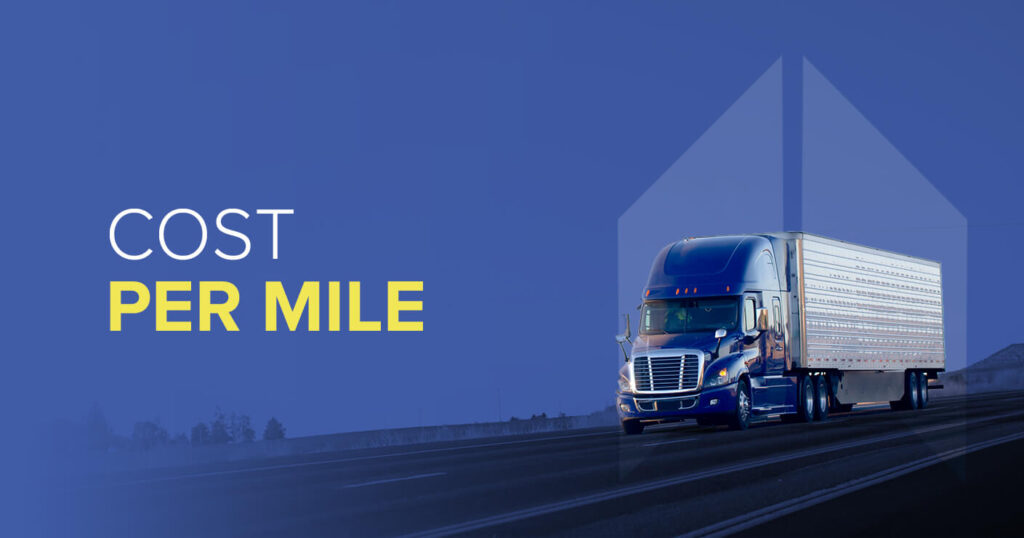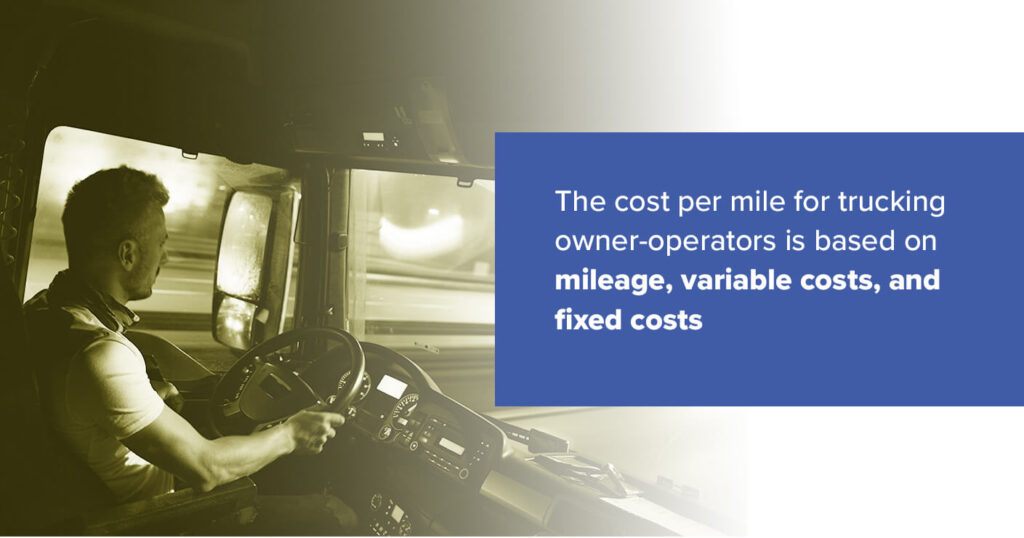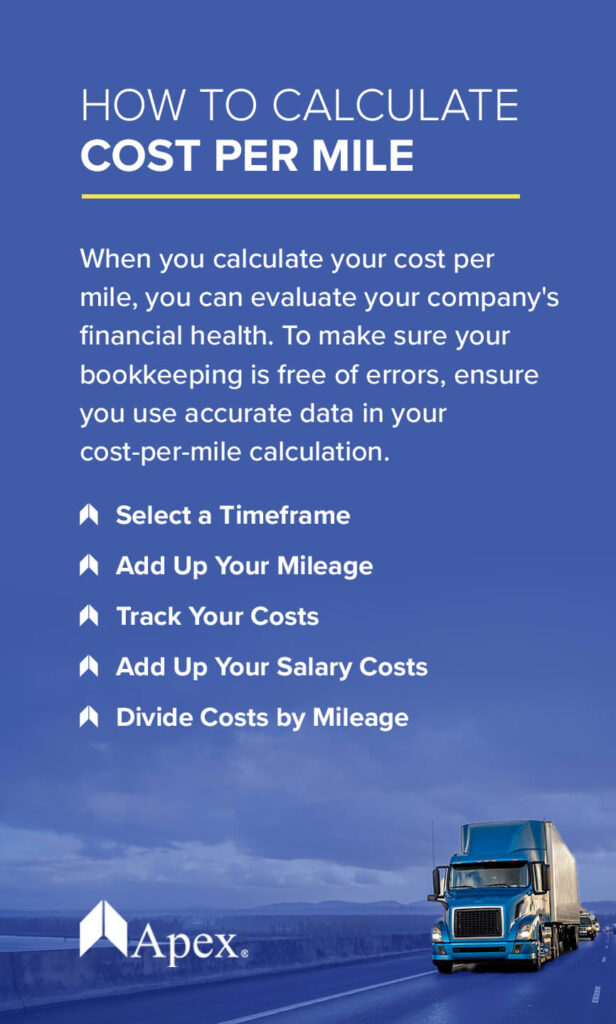As a trucker, driving is how you make your money, but it also comes with its costs. Your average cost per mile is one of the most important numbers to calculate and understand for the success of your business. Once you have this number, you can use it as a tool to make informed business decisions.
Running a trucking business means you need to spend money to make money, and whether you own a small trucking business or an entire fleet of 100 trucks, you’ll need to manage variable and fixed expenses. Budgeting is key, along with knowing when to spend and where you can save. When you know your cost per mile, you can simplify your financial planning, and you may even be able to find ways to lower your costs.
What Is Cost Per Mile?
Cost per mile is your cost for operating each mile you drive. In simple terms, your cost per mile is your total costs divided by the number of miles driven. Figuring out your cost per mile is essential for knowing what minimum freight rate you should accept when booking loads.
If you own a truck or a freight company, you’ll need to cover a wide range of expenses each month. Between truck maintenance, fuel, food, and lodging, expenses can quickly add up. This is why consolidating your expenses into a single metric like cost per mile can help you run your business more efficiently.
Factors in Cost Per Mile Calculation
The cost per mile for trucking owner-operators is based on mileage, variable costs, and fixed costs:
- Mileage: Mileage may include both your compensated miles and deadhead or empty miles. Compensated miles are those you drive while hauling a load, while deadhead miles are those you drive after completing a delivery and your truck is empty. Typically, deadhead or empty miles are not being paid by a customer, but these miles are an unavoidable expense to your company that can add wear and tear to your vehicle.
- Variable costs: Your business’s variable costs are the expenses that vary by month, such as utilities and hourly employee wages. Variable costs related to your cost per mile may include fuel, licensing, tolls, tires, and vehicle repairs and maintenance. Though these costs may be within a similar range from month to month, the exact number isn’t the same. You should have a system for tracking these costs.
- Fixed costs: Your fixed costs are your business’s unchanging expenses. Typically, fixed costs are monitored and tracked by accounting software, such as insurance premiums, rent, salaries, and truck payments. Unless there’s a change in how your business operates, you’ll only need to add up your fixed costs once to calculate your cost per mile.
You’ll take these factors into consideration when calculating your cost per mile.
How to Calculate Cost Per Mile
When you calculate your cost per mile, you can evaluate your company’s financial health. To make sure your bookkeeping is free of errors, ensure you use accurate data in your cost-per-mile calculation.
1. Select a Timeframe
First, you need to decide on a time period for your calculation. When calculating your cost per mile for the first time, you may want to choose a shorter timeframe, such as a week, so you’ll have less data to collect and smaller figures to deal with.
Once you calculate your cost per mile over a short time period, select a longer timeframe that’s more aligned with the way you track your other metrics and makes more sense for how your company operates. For your business, this could mean monthly, quarterly, or semi-annual tracking.
2. Add Up Your Mileage
During the time period you select, you’ll track your number of miles driven. You may already have a system in place to track your mileage so you can get reimbursed by the Internal Revenue Service (IRS). If your business doesn’t have a system already, you can calculate your mileage manually via your odometer readings and a physical log or you can use software that automates the process.
For example, you may note that at the start of the month, your odometer read 70,000 miles. At the end of that month, your odometer reads 82,000 miles. This means you drove 12,000 miles that month.
3. Track Your Costs
Track your costs during the same timeframe in which you tracked your mileage. Start by making a list of your fixed costs during this timeframe, such as:
- Rent
- Salaries
- Truck payment
- Bank fees
- Subscriptions
- Truck insurance
- Trailer payment
- Workers’ compensation
Add up these expenses to get the total of your fixed costs. Next, list and add up your variable costs, such as:
- Fuel
- Taxes
- Tolls
- Meals
- Utilities
- Rooms
- Permits
- Repairs
- Driver pay
- Maintenance
- Factoring or dispatching
Add your fixed and variable costs together to determine your total costs.
For example, maybe you spend $500 on rent, $1,000 on your truck payment, $75 on permits, and $200 on insurance over the course of a month. This would make your fixed expenses $1,775 for the month. During this month, you also spent $150 on utilities, $100 on tolls, and $400 on fuel. Your variable costs for the month would be $650. Your total monthly expenses would be $2,425.
4. Add Up Your Salary Costs
Regardless of whether you run a solo operation or a fleet of trucks, you draw or pay a salary, along with employment costs. Potential salary costs you may need to add up include:
- Wages
- Taxes
- Benefits
- Payroll fees
If you don’t have any employees but you pay yourself $3,500 a month, this would be your salary expense.
5. Divide Costs by Mileage
When you know your total expenses and mileage, calculating your cost per mile is simple. Divide your total costs by your total miles driven to get your cost per mile. For example, if your company drives 500,000 miles in a year and your total annual costs are $10,000,000, your cost per mile is $20.00. For a 300-mile trip, you could expect a cost of about $6,000.
Along with your monthly miles driven and your monthly and annual overhead costs, it’s important to know your truck’s miles per gallon, the price per gallon of diesel, and the driver’s wage per mile. After calculating your cost per mile, use an online calculator to check your math.
Importance of Cost Per Mile for Trucking Companies
Your cost per mile is essential to know and understand for the success of your trucking company. Below are some of the reasons why calculating your cost per mile is important.
1. Figure Out Whether You Can Make a Profit
One of the most crucial reasons for calculating your cost per mile is figuring out how much revenue you require per mile to make a profit. For example, if your cost per mile is $1.50, a rate of $1.50 means you’re breaking even. Rates that shippers and brokers are paying above $1.50 mean you’re making a profit.
2. Determine Whether to Take a Load
When you know your cost per mile, you can determine whether it’s worthwhile for you to take a load based on the rate offered. Use your cost per mile and the rate to calculate whether you’d make a profit. If your cost per mile is $1.50, for example, you’ll want a rate above this to ensure you make a profit. When you know your fixed and variable expenses, your calculation will be even more precise.
Knowing your numbers can help you ensure you’re covering your costs and making money. This calculation will also help you budget for each trip and determine how much you can allocate to different costs, such as fuel, meals, and lodging. Cost per mile allows you to quickly determine whether a delivery will turn a good profit or whether you should avoid it.
3. Find Ways to Reduce Your Trucking Company’s Costs
Once you know your cost per mile, you can analyze your expenses and look for ways to save money. Examine your trucking expenses spreadsheet or review these items in your software. If there are expenses you believe could be reduced, such as some of your variable expenses, you could grow your trucking company.
Keep in mind there are some areas in which you shouldn’t cut corners, such as your drivers, technology, and services. Your drivers are the key to your trucking company’s success, so you should invest in them with competitive wages and benefits. Your technology should promote the growth of your company. Additionally, the services you invest in should be high-quality and give you the tools you need to grow your business.
4. Identify Potential Costs Due to Repairs and Maintenance
When you calculate your average cost per mile, you can assess your typical cost per mile in maintenance and repairs. If you notice your rate for repairs or maintenance has suddenly increased, you can analyze whether this increase is due to an expensive mechanic or a truck getting old. If your truck is becoming costly to maintain and repair, it may be time to purchase a new one.
5. Become a Better Trucking Business Owner
Understanding your cost per mile will help you improve your business operations and become a better owner-operator. Whether your company is new or has been operating for years, calculating your cost per mile can help you analyze how your business is running and where you may be able to make improvements.
How to Reduce Cost Per Mile
Some of your operating costs cannot be eliminated, but you may be able to find ways to reduce them. A few of the factors you may be able to adjust to reduce your cost per mile include your mileage and fuel costs.
1. Lower Your Mileage
To reduce your cost per mile, the key is lowering your mileage. Though there are many other operating costs you can’t reduce or eliminate, lowering your mileage means you can reduce your fuel cost, which is one of the biggest expenses trucking businesses face. Many truckers drive hundreds of miles a day, so reducing your mileage is one of the best ways to lower fuel costs.
Practice efficient driving tactics that inspire money-saving habits, such as optimizing routes to take the most direct path. You’ll need to consider a few factors for route optimization, such as vehicle load capacity, standard traffic conditions, each individual stop, and when customers are available for the completion of deliveries. This will help your company spend less on fuel and reduce your average cost per mile.
2. Reduce Your Fuel Costs
Along with lowering your mileage, you may want to assess your cost of fuel per mile. If you notice an increase in cost, consider whether your fuel card is getting you good discounts and whether you’re purchasing fuel from the best place.
Some fuel cards offer discounts when you pump your fuel. This can be a great way to save. Similarly, you may be able to get discounts at a truck maintenance service center. Along with seeking discounts, try to avoid deadhead miles, monitor your idling, and strategically plan your routes to reach maximum fuel efficiency.
Our Apex TCS Fuel Card provides our clients with savings at an average of 45 cents per gallon across more than 1,500 locations where you won’t pay $0 transaction fees. When you factor with us, you can also qualify for a $2,500 fuel card credit line.
Additionally, reduce your out-of-route miles, as these cause additional wear and tear and burn unnecessary fuel. Monitor reported miles versus actual miles to flag driver behavior and assess whether out-of-route miles can be reduced or eliminated.
3. Decrease Reactive Maintenance
You can rely on maintenance services while you’re on the road, but this isn’t the most cost-effective or efficient solution for maintenance issues. When unexpected, expensive breakdowns occur, they can negatively affect your:
- Finances
- Drive time
- Delivery schedules
- Customer service
By making use of some maintenance practices, you can avoid the headache of needing repairs on the road, potential issues, and major maintenance costs. You may also want to implement a system that automatically flags high-priority maintenance for safety-related issues. Invest in a regular maintenance schedule with a service provider you trust.
Get Paid the Fastest Way With Apex Capital
At Apex, we get truckers paid fast. Since opening our doors in 1995, we’ve been providing factoring services to truckers and trucking companies. If you’re a trucker, we want to make a difference in your life. We always aim to do the right thing, take care of our customers and employees, build a work environment to promote teamwork and positivity and give back to our community.
Our services include:
We understand the importance of cost per mile for trucks and its impact on your business. Our fuel card program can help you save on diesel at a rate of about 45 cents per gallon*. Contact us at Apex to get paid today.



